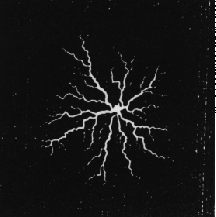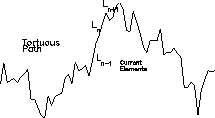
The hypothesis of this work is that the structure of the red sprites can be attributed to the fact that the power density generated by lightning does not have the smooth characteristics expected from the dipole model of Eq. 7, but the structured form expected from a fractal antenna [ Kim and Jaggard, 1986; Werner et al., 1995]. Previous studies of lightning assumed that the RF fields causing the atmospheric heating and emissions, were produced by an horizontal dipole cloud discharge moment M that generates an electric field at the height z, given by
where c is the velocity of light and  is the permitivity of
free space. It is important to realize that a lightning discharge must be
horizontal, as in intracloud lightning, to project the energy upwards into
the lower ionosphere. A vertical discharge, as in cloud-to-ground lightning,
will radiate its energy horizontally as a vertical antenna.
is the permitivity of
free space. It is important to realize that a lightning discharge must be
horizontal, as in intracloud lightning, to project the energy upwards into
the lower ionosphere. A vertical discharge, as in cloud-to-ground lightning,
will radiate its energy horizontally as a vertical antenna.
It is obvious that such a horizontal dipole results in electric fields that
vary smoothly with distance. However, it is well known that lightning
discharges follow a tortuous path [LeVine and Meneghini, 1978]. It
was shown [ Williams, 1988] that intracloud discharges resemble the
well known Lichtenberg patterns observed in dielectric breakdown. In fact a
time-integrated photograph of a surface leader discharge is illustrated by
Figure 11 . These patterns have been recently identified as fractal
structures of the Diffusion Limited Aggregate (DLA) type with a fractal
dimension  [Sander, 1986; Niemeyer et al.,
1984].
[Sander, 1986; Niemeyer et al.,
1984].

Figure 11: Time-integrated photograph of a surface leader discharge
(Lichtenberg pattern) [Niemeyer et al., 1984]
As noted previously, the tortuous path increase the effective dipole moment,
since now the pathlength along the discharge is longer that the Euclidean
distance. To understand this analogy, we construct a tortuous walk between
two points separated by a distance R as shown in Fig 12. Take the
tortuous path as N small steps of averaged step length  , then the
total path length S along the tortuous discharge is
, then the
total path length S along the tortuous discharge is

where the number of small steps is  with D as the
box counting dimension [Ott, 1993]. As we have seen before, the
change in the path length increases the radiated power density as E
with D as the
box counting dimension [Ott, 1993]. As we have seen before, the
change in the path length increases the radiated power density as E where E
where E Therefore, for
Therefore, for  km (typical for an intracloud discharge),
km (typical for an intracloud discharge),  m,
m,  , and
, and  , with obtain
, with obtain  where f is the frequency of the current.
where f is the frequency of the current.

Figure 12: Tortuous path between two point.
This is only an analogy, but it gives us good intuition that a fractal
lightning discharge will produce an increase in the radiated field
intensity, at least locally, as compared with a dipole model and a spatially
structured radiation pattern. A fractal dielectric discharge of size R can
be modeled as a set of non-uniformly distributed small current line elements
[ Niemeyer et al., 1984] that represent the steps of the discharge
breakdown as it propagates during an intracloud lightning discharge. The
size of the elementary current steps is about  m [Uman,
1987]. As a current pulse propagates along this horizontal fractal discharge
pattern it radiates energy upwards (see Appendix A on how the fields are
calculated) as well as downward.
m [Uman,
1987]. As a current pulse propagates along this horizontal fractal discharge
pattern it radiates energy upwards (see Appendix A on how the fields are
calculated) as well as downward.
To determine the extent over which the non-uniformity of the lightning discharge current affects the power density structure projected in the lower ionosphere, we will now construct a simple fractal model of the lightning discharge that will yield a spatio-temporal radiation pattern at the relevant heights.